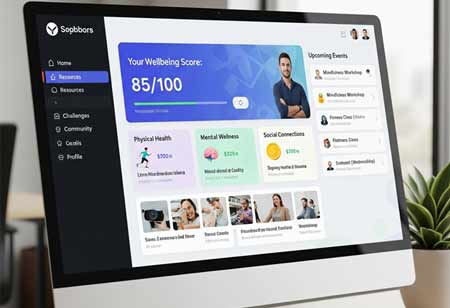THANK YOU FOR SUBSCRIBING
Be first to read the latest tech news, Industry Leader's Insights, and CIO interviews of medium and large enterprises exclusively from Hrtech Outlook
THANK YOU FOR SUBSCRIBING

By
HR Tech Outlook | Friday, October 31, 2025
Stay ahead of the industry with exclusive feature stories on the top companies, expert insights and the latest news delivered straight to your inbox. Subscribe today.
Employee wellbeing platforms are transforming how organizations support their workforce by addressing health, resilience, and engagement holistically. These platforms combine physical health tools, mental wellbeing resources, financial planning support, and professional growth opportunities within unified ecosystems.
By integrating data-driven personalization, telehealth access, and inclusive design, they meet the diverse needs of modern employees. Employers can achieve measurable returns through improved retention, reduced absenteeism, and enhanced productivity. As workplace expectations evolve, wellbeing platforms stand as essential enablers of organizational performance and employee satisfaction.
Market Trends Shaping Employee Wellbeing Platforms
Employee wellbeing platforms have become central to organizational strategies that seek to retain talent, boost productivity, and foster a resilient workforce. Demand is expanding across sectors as employers recognize wellbeing as a holistic construct encompassing physical health, mental resilience, financial security, social connection, and professional development.
Platforms now present multi-dimensional offerings that combine health assessments, mental health support, fitness and nutrition programs, financial planning tools, and personalized learning pathways. This integrated approach reflects a market preference for single ecosystems that reduce friction and deliver coordinated experiences for employees and administrators alike.
Personalization is a defining trend. Wellbeing platforms harness data from assessments, wearable devices, and engagement metrics to tailor interventions to individual needs and risk profiles. Adaptive content delivery increases relevance and uptake, shifting programs away from one-size-fits-all campaigns toward continuous, individualized support.
Seamless integrations with HR systems and single-sign-on infrastructures have become expectations, enabling streamlined enrollment, benefits navigation, and anonymized outcomes reporting that preserves privacy while informing leadership.
Another movement emphasizes accessibility and inclusivity. Platforms are expanding language support, culturally competent content, and flexible delivery modes such as mobile apps, telehealth, and asynchronous microlearning, ensuring reach across dispersed and shift-based workforces.
Employer investment models are diversifying to include voluntary, employer-sponsored, and hybrid funding arrangements that accommodate differing organizational sizes and budget priorities. Measurement and ROI are increasingly sophisticated, with stakeholders seeking evidence of impact through engagement metrics, reduced absenteeism, improved retention, and correlations to performance indicators.
Regulatory and ethical considerations are influencing platform design. Data privacy, consent frameworks, and mental health safeguarding shape feature roadmaps, pushing vendors to embed transparent governance and clinician oversight into offerings. Employers prioritize platforms that demonstrate compliance with privacy standards and offer robust escalation pathways for employees in crisis.
Barriers and Practical Solutions
Adoption can be hindered when platforms are perceived as generic wellness apps rather than strategic instruments for workforce resilience. The solution is framing wellbeing platforms as part of a broader organizational ecosystem that aligns with cultural values, leadership behavior, and people strategies.
Embedding wellbeing into performance conversations, career development, and manager training turns offerings into everyday practices rather than optional perks. Communication strategies that highlight stories of impact and provide clear participation pathways increase legitimacy and sustained engagement.
Data fragmentation across HR systems, health providers, and individual devices hinders the ability to gain coherent insights. A practical remedy is the adoption of interoperable architectures and standardized data schemas that enable secure aggregation without compromising privacy.
Consent-driven data models, anonymized analytics, and role-based reporting provide decision-makers with actionable trends while protecting individual confidentiality. APIs and middleware that connect payroll, benefits, and learning management systems simplify administration and reduce manual reconciliation overhead.
Budget constraints often limit comprehensive deployment, especially in smaller organizations. Creative financing and phased rollouts address this challenge. Starting with core modules that deliver immediate value, such as mental health support or primary care navigation, and expanding via subscription tiers enables measurable impact before committing to broader investment. Employer-employee cost-sharing models and partnerships with benefits brokers or pooled purchasing arrangements lower entry barriers and widen access.
Measuring impact presents complexity when outcomes like resilience or morale are inherently qualitative. Solutions combine quantitative metrics with qualitative feedback frameworks. Aggregated engagement rates, utilization of services, reductions in short-term absenteeism, and turnover differentials form a quantitative baseline, complemented by pulse surveys, focus groups, and narrative case studies that capture employee experience. Dashboards that map wellbeing indicators to business outcomes support strategic decision-making and continuous improvement.
Advancements and Opportunities Delivering Stakeholder Value
Technological advancements are unlocking more impactful, scalable wellbeing solutions that deliver measurable value to employees, HR leaders, and organizational stakeholders. Artificial intelligence is enhancing personalization by matching users with relevant resources, predicting risk patterns, and optimizing intervention timing. AI-driven chatbots and triage systems expedite access to mental health resources while routing complex cases to licensed clinicians, increasing capacity without sacrificing quality. For stakeholders, these capabilities translate into faster support pathways and more efficient allocation of clinical resources.
Telehealth integration improves employee access to virtual clinicians for counseling, primary care, and specialist referrals, overcoming geographic and scheduling barriers. Coordinated care pathways enhance continuity and health outcomes while streamlining administrative processes, leading to increased health engagement and potentially lower healthcare costs for employers.



